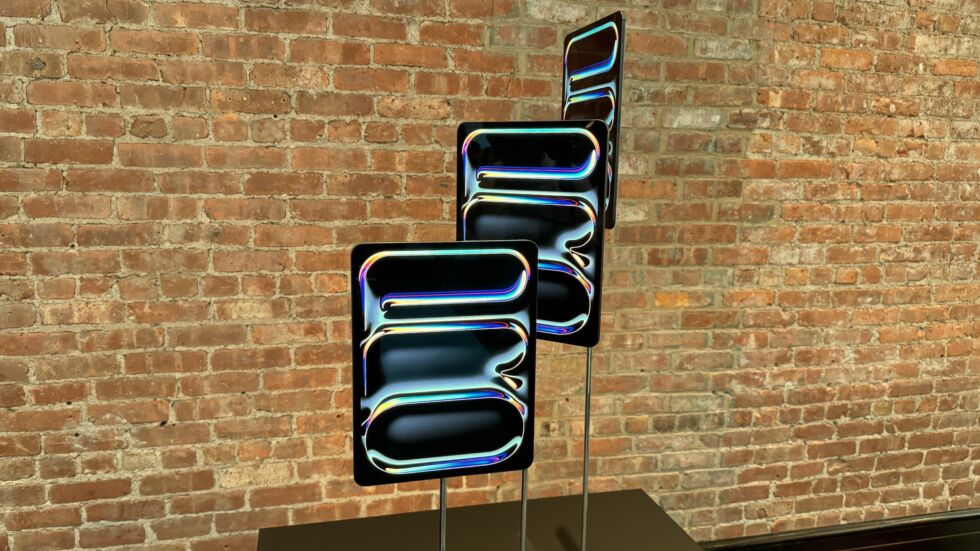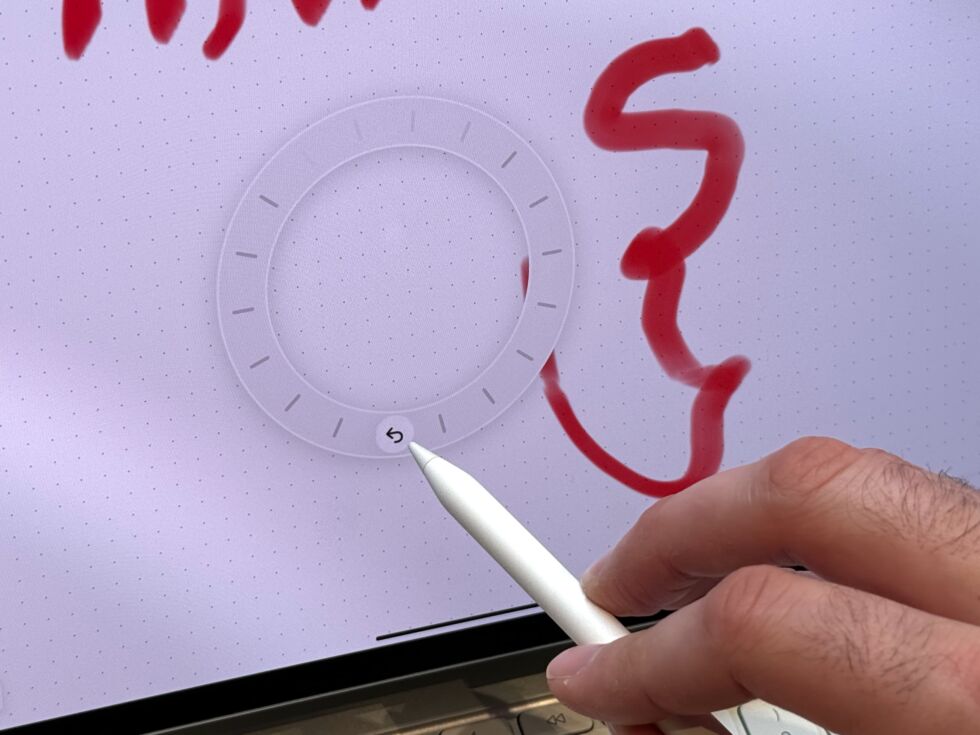
Apple has a new lineup of iPad Pro and Air models for the first time in well over a year. Most people would probably be hard-pressed to tell the new ones from the old ones just by looking at them, but after hands-on sessions with both sizes of both tablets, the small details (especially for the Pros) all add up to a noticeably refined iPad experience.
iPad Airs: Bigger is better
But let's begin with the new Airs since there's a bit less to talk about. The 11-inch iPad Air (technically the sixth-generation model) is mostly the same as the previous-generation A14 and M1 models, design-wise, with identical physical dimensions and weight. It's still the same slim-bezel design Apple introduced with the 2018 iPad Pro, just with a 60 Hz LCD display panel and Touch ID on the power button rather than Face ID.
So when Apple says the device has been "redesigned," the company is mainly referring to the fact that the webcam is now mounted on the long edge of the tablet rather than the short edge. This makes its positioning more laptop-y when it's docked to the Magic Keyboard or some other keyboard.
AdvertisementThe most welcome change to the Air is the introduction of a 13-inch model (blessedly, no longer "12.9 inches"). It looks like the old 12.9-inch iPad Pro design from circa 2018 but with the simpler single-lens 12 MP camera and the Touch ID button rather than the Face ID sensor.

With the iPad Pro and the Air next to each other, it's clear which has the superior screen—the 120 Hz refresh rate of ProMotion and the infinite contrast of OLED are definitely major points in the Pro's favor. But if you're just looking for a big screen for watching videos, reading books, or playing games, or if you're just looking for a general-use laptop replacement tablet, Apple is still using a great 60 Hz LCD panel here. And the $799 price tag is considerably lower than any of Apple's past 12.9-inch iPad Pros.
Like the 15-inch MacBook Air, it's a way for people to get a bigger screen without paying for advanced screen technologies or faster processors if they don't want or need them. It's hard to find a downside to that, as long as you're OK with iPadOS' differences and restrictions relative to macOS.
iPad Pro: Stunning screen, surprisingly light

The first thing I noticed when I got my hands on the new iPad Pro was the size and weight rather than the screen (though I think it was the opposite for my Ars colleague Samuel Axon, whose dislike of LCD display technology is a frequent topic of conversation in the Ars Orbiting HQ). The 13-inch model, in particular, is about a fifth of a pound lighter than the old 12.9-inch iPad Pro, which you definitely feel if you're holding the tablet in one hand and an Apple Pencil in the other.
On the topic of the screen, though, it really does look very good in person. Apple's hands-on corral for the media was in a well-lit but still indoor space, which probably isn't the perfect environment for appreciating the brightness of Apple's layered OLED displays. But it's definitely a notable improvement over the mini LED technology in older 12.9-inch iPad Pro screens, which improved on typical LCD displays but still exhibited light bloom. That's even more true of the 11-inch iPad Pro, which was saddled with lesser screen tech in previous generations but now benefits from the exact same screen as the 13-inch model.

There's not a ton to be said about the new Magic Keyboard accessory, which, like the tablet itself, is a little thinner and lighter than the old one but has the same key switches and so feels mostly familiar. The added function row is nice, as is the somewhat larger trackpad, and the metal wrist rest makes it feel even more like an oddball MacBook Air than the old Magic Keyboard.
AdvertisementThe worst thing about the Magic Keyboard is still its price; the device adds $299 to the 11-inch Pro and $349 to the 13-inch Pro. If you intend to use either as a laptop replacement, that automatically boosts the base price up to $1,300 and $1,650, and that's before you even consider any storage upgrades. It's an amount you'll want to pay only if you're truly all-in on the iPad Pro as a laptop replacement.
- The OLED display, available on both the 11- and 13-inch Pros, looks very nice in person.Andrew Cunningham
- It's even more stunning in photos with lots of contrast—you get deep black colors, but also bright spots with no bloom.Andrew Cunningham
- The back of the iPad Pro. It's still an iPad.Andrew Cunningham
- A slightly reformulated rear camera array.Andrew Cunningham
- Even with nothing else for scale, the new iPad Pros are impressively thin. The 13-inch model is also significantly lighter.Andrew Cunningham
One note about the "nano-texture glass," a specific type of display etching that Apple does to give some of its glassy displays a matte finish. It only adds $100 to the total cost of either iPad Pro, but it's also only available with the 1TB or 2TB storage capacities. The base price for a Pro with nano-texture glass is effectively $1,699 for the 11-inch and $1,999 for the 13-inch.
Something we didn't really get to appreciate in our hands-on session was the M4 chip—when you're just zipping between productivity apps and scribbling with the Pencil, the M4 doesn't feel appreciably different from the M1 in my 5th-generation iPad Air. The chip did easily handle the tightly controlled demos of the new Final Cut and Logic Pro apps that Apple demonstrated—but we didn't get to see how those apps would run on an iPad with an M1 or M2 in it, so it's difficult to say how much faster the M4 will feel in daily use even if you're really pushing the hardware. We'll do some more comparisons in our full review.
Apple Pencil Pro: Subtle refinements

The new Apple Pencil Pro only works with the M2 iPad Airs and M4 iPad Pros, so users of older Airs and Pros can't upgrade to get any of the new features (the second-generation Apple Pencil also won't work with the new tablets, according to Apple's site, so if you replace your tablet, you need to replace your Pencil, too).
If you get one of the new iPads, drawing with the new Pencil is improved in subtle but interesting ways. Squeezing the Pencil now triggers a radial menu for pen and color selection, the same toolbox that is currently tucked away at the bottom of the screen on older iPads. (Apps can create their own custom radial menus for this, too.) Gentle haptic feedback triggers when you squeeze the Pencil Pro to let you know you did it right.
You'll also feel some bumps of haptic feedback when you're using the new radial undo and redo controls, activated by holding down the Pencil Pro on either button. A circular menu appears onscreen, and you can slide the Pencil backward on the wheel to undo multiple things at once or forward to redo the things you just did. This is handy for quickly undoing errant brushstrokes or entire words you want to delete.
Advertisement
The other major refinement Apple showed off was the way that your pen tip would spin around with the Pencil Pro as you twirl it in your fingers, making it easier to change the angle of your lines (of Apple's built-in pen tips, it was most noticeable when using the highlighter tip). The Pencil now casts a "shadow" on the screen when it's close enough, showing you exactly what you're about to draw as you roll the Pencil around in your hand.
It is a little frustrating that Apple now sells three separate, similar-looking Apple Pencil models that are all compatible with a different list of models, plus the first-generation Lightning-equipped Apple Pencil for older iPads. (The first-gen Apple Pencil works with the $349 iPad via a USB-C-to-Lightning adapter, but just get the $79 USB-C Apple Pencil instead.)
The $79 USB-C Apple Pencil is easy enough to figure out—it's the cheaper option with fewer features, and it works with all post-2018 iPad, iPad Air, and iPad Pro models, including the new ones introduced today. As for the others, buy the Pencil Pro for the new M2 iPad Air or M4 iPad Pro. Buy the second-generation Apple Pencil for anything else. Both cost the same $129, despite one having "Pro" in its name, so the one you want depends entirely on the tablet you're buying it for.



















